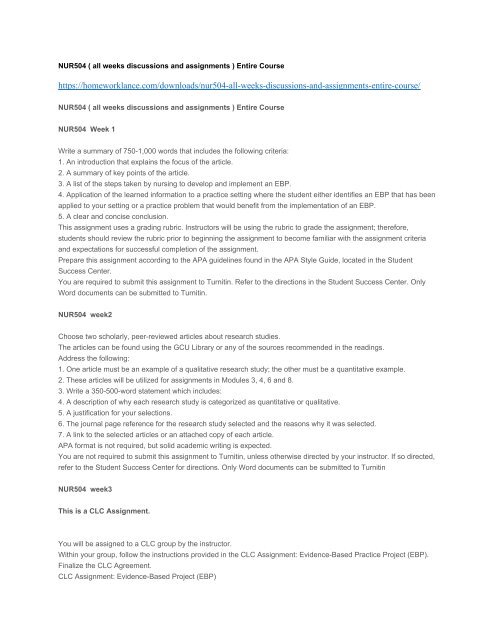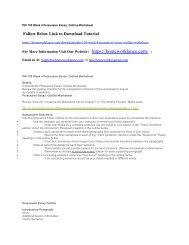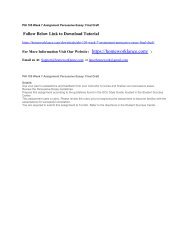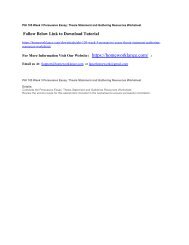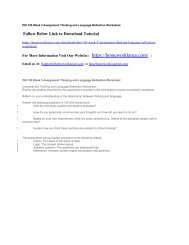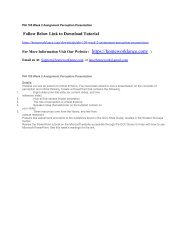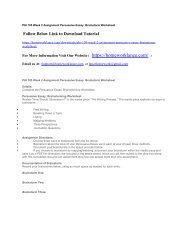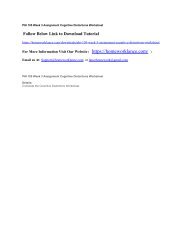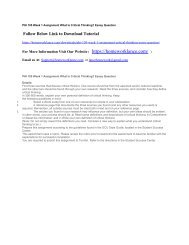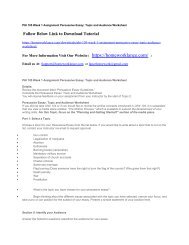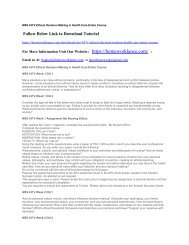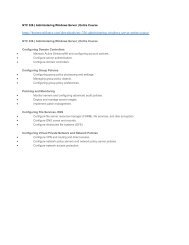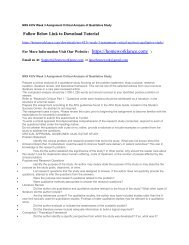NUR504 ( all weeks discussions and assignments ) Entire Course
Create successful ePaper yourself
Turn your PDF publications into a flip-book with our unique Google optimized e-Paper software.
<strong>NUR504</strong> ( <strong>all</strong> <strong>weeks</strong> <strong>discussions</strong> <strong>and</strong> <strong>assignments</strong> ) <strong>Entire</strong> <strong>Course</strong><br />
https://homeworklance.com/downloads/nur504-<strong>all</strong>-<strong>weeks</strong>-<strong>discussions</strong>-<strong>and</strong>-<strong>assignments</strong>-entire-course/<br />
<strong>NUR504</strong> ( <strong>all</strong> <strong>weeks</strong> <strong>discussions</strong> <strong>and</strong> <strong>assignments</strong> ) <strong>Entire</strong> <strong>Course</strong><br />
<strong>NUR504</strong> Week 1<br />
Write a summary of 750-1,000 words that includes the following criteria:<br />
1. An introduction that explains the focus of the article.<br />
2. A summary of key points of the article.<br />
3. A list of the steps taken by nursing to develop <strong>and</strong> implement an EBP.<br />
4. Application of the learned information to a practice setting where the student either identifies an EBP that has been<br />
applied to your setting or a practice problem that would benefit from the implementation of an EBP.<br />
5. A clear <strong>and</strong> concise conclusion.<br />
This assignment uses a grading rubric. Instructors will be using the rubric to grade the assignment; therefore,<br />
students should review the rubric prior to beginning the assignment to become familiar with the assignment criteria<br />
<strong>and</strong> expectations for successful completion of the assignment.<br />
Prepare this assignment according to the APA guidelines found in the APA Style Guide, located in the Student<br />
Success Center.<br />
You are required to submit this assignment to Turnitin. Refer to the directions in the Student Success Center. Only<br />
Word documents can be submitted to Turnitin.<br />
<strong>NUR504</strong> week2<br />
Choose two scholarly, peer-reviewed articles about research studies.<br />
The articles can be found using the GCU Library or any of the sources recommended in the readings.<br />
Address the following:<br />
1. One article must be an example of a qualitative research study; the other must be a quantitative example.<br />
2. These articles will be utilized for <strong>assignments</strong> in Modules 3, 4, 6 <strong>and</strong> 8.<br />
3. Write a 350-500-word statement which includes:<br />
4. A description of why each research study is categorized as quantitative or qualitative.<br />
5. A justification for your selections.<br />
6. The journal page reference for the research study selected <strong>and</strong> the reasons why it was selected.<br />
7. A link to the selected articles or an attached copy of each article.<br />
APA format is not required, but solid academic writing is expected.<br />
You are not required to submit this assignment to Turnitin, unless otherwise directed by your instructor. If so directed,<br />
refer to the Student Success Center for directions. Only Word documents can be submitted to Turnitin<br />
<strong>NUR504</strong> week3<br />
This is a CLC Assignment.<br />
You will be assigned to a CLC group by the instructor.<br />
Within your group, follow the instructions provided in the CLC Assignment: Evidence-Based Practice Project (EBP).<br />
Finalize the CLC Agreement.<br />
CLC Assignment: Evidence-Based Project (EBP)
Group work has benefits <strong>and</strong> liabilities. Everyone assigned to a CLC is expected to equ<strong>all</strong>y participate in the work in<br />
terms of time <strong>and</strong> quality of effort. The assignment should be apportioned to make the best use of the strengths of<br />
individual team members. Some of you are natural leaders. Your strengths can be your greatest liabilities. No one<br />
wants to be bossed around no matter how skilled the boss. Honest communication is critical to effective group work.<br />
The best way to avoid conflict is to set very clear expectations. Then, if someone does not do what is expected, he or<br />
she can be referred to the original agreement rather than have the confrontation become personal.<br />
At the end of the project, students will have an opportunity to evaluate each other. These evaluations will be taken<br />
into consideration when grading individuals within the group. The grade will be given for the project as compared to<br />
the rubric for evaluation. Depending on your evaluations, individual grades will be equal to or less than the over<strong>all</strong><br />
grade. <strong>Course</strong> faculty are able to observe the process in the CLC forum. If your work takes place outside the forum,<br />
this information will be absent. Be certain, even if you communicate via e-mail, phone, or face-to-face, to record the<br />
communication in the CLC forum.<br />
NOTE: The final course of your program will require you to develop <strong>and</strong> implement an EBP guideline. This is your<br />
opportunity to learn the process <strong>and</strong> perhaps even identify an area of interest. Your choice of a topic for the capstone<br />
course should be related to your area of specialty. Each course you take will provide you with the opportunity to<br />
investigate theory <strong>and</strong> empirical literature to identify the relevant evidence you will need to complete this project. The<br />
more effort you expend now to learn this process, the easier it will be for you to complete the program efficiently.<br />
Topic 1:<br />
Collaborative Learning Community: EBP Agreement<br />
1) Check into your CLC group.<br />
a) Describe your prior experience with evidence-based practice (EBP) includingparticipation in developing EBP<br />
guidelines or protocols for changing practice.<br />
CLC Agreement<br />
1) Review the CLC Agreement<br />
a) Choose one member totransfer the CLC Agreement to the CLC forum, input the CLC’s responses for <strong>all</strong> sections<br />
of the Agreement, <strong>and</strong> submit the CLC Agreement.<br />
b) Each member should provide their contact information on the CLC Agreement <strong>and</strong> decide what tasks in the Project<br />
Management Specifics section they will be responsible for.<br />
c) In the CLC Forum, discuss <strong>and</strong> provide responses for each component of the CLC Agreement. The CLC Group<br />
Review Process will be completed at the end of your project.<br />
d) Discuss the advantages <strong>and</strong> disadvantages of working in a team environment.<br />
2) Record <strong>all</strong> communication in the CLC Forum.<br />
3) Complete the CLC agreement, except for the CLC Group Review Process.<br />
4) Submit the completed CLC Agreement to the instructor at the end of Topic 2.<br />
Topic 2:<br />
Collaborative Learning Community: EBP Agreement.<br />
Brainstorm: Initiate conversation regarding potential topics of interest.<br />
1) This should be a nursing related problem, that is, a problem related to nursing practice, advance practice,<br />
leadership, or education. .<br />
2) Identify several topics of interest <strong>and</strong> have individual group members do a quick survey of the literature to be sure<br />
that there is evidence available.<br />
3) In order to develop a guideline/protocol, you will need credible resources. Read pages 29-34 for guidance in
identifying sources of evidence.<br />
a) The course readings include <strong>all</strong> of the information needed to complete this project. Chapters 1 <strong>and</strong> 2 provided the<br />
necessary information regarding EBP <strong>and</strong> how to find evidence. Chapter 5 provides strategies for locating credible<br />
information. The sooner these chapters are read carefully, with the project in mind, the easier it will be.<br />
4) Record <strong>all</strong> communication in the CLC Forum.<br />
Topic 3:<br />
Collaborative Learning Community: EBP Identification of Clinical Question<br />
1) Refer to Figure 2.2 in the textbook for the model you will use to complete this project.<br />
a. Note that you will not complete the entire process in this model, you will reach the step entitled,Pilot the change in<br />
practice.<br />
2) As a group, finalize your choice of topic.<br />
a. Review the literature regarding clinical problems presented in the previous topic in order to ensure that there is<br />
adequate evidence for your choice.<br />
b. State your topic in the form of a problem statement <strong>and</strong> a foreground question.<br />
c. The course readings include <strong>all</strong> of the information you need to complete this project.<br />
d. Record <strong>all</strong> communication in the CLC Forum.<br />
3) Choose one team member to submit the completed assignment <strong>and</strong> initial reference list to the instructor by the end<br />
of Topic4.<br />
Topic 4:<br />
Collaborative Learning Community: EBP Literature Search/Appraisal of Evidence<br />
1) UseFigure 2.1, Evidence hierarchy pyramid, inthe textbook as your guide for the levels of evidence in your<br />
reference list.<br />
2) Locate case studies, relevant clinical articles written by experts, research articles,, evidence based guidelines <strong>and</strong><br />
protocols<strong>and</strong> theory that may guide the identification of appropriate solutions. This can include the articles reviewed<br />
from topic 3. Note, not <strong>all</strong> theories will have research that <strong>all</strong>ows them to have a level assigned to them. This does not<br />
mean they are not good theories.<br />
3) Appraise the evidence using the guidelines provided on pages 37-40 in the textbook.<br />
a. Use these guidelines to discard references that are untrustworthy or irrelevant.<br />
b. Use Box 2.2 to help with this decision-making process.<br />
4) Use the following to organize the evidence by commonalities <strong>and</strong>/or contrary findings:<br />
a. Chapter 5in the textbook provides information regarding how to synthesize the article findings.<br />
b. Use the EBP Project Evaluation tool located in resources to consolidate <strong>and</strong> present the findings<br />
5) Record <strong>all</strong> communication in the CLC Forum.<br />
Topic 5:<br />
Collaborative Learning Community: EBP Literature Search/Appraisal of Evidence<br />
1) Continue with the articles used inTopic 4.<br />
2) Complete the Synthesis Table for the evidence <strong>and</strong> variables for the guideline.<br />
a. Limit the articles to no more than ten; two per student in the CLC group would be reasonable.<br />
b. A true proposal would require a comprehensive review of the literature <strong>and</strong> inclusion of <strong>all</strong> relevant works.<br />
3) Record <strong>all</strong> communications in the CLC Forum.
Topic 6:<br />
Collaborative Learning Community: EBP Develop Clinical Guideline <strong>and</strong> Implementation Plan<br />
1) Initiate work on developing a guideline or protocol based on your search of the literature.<br />
2) Consider how to implement the intervention to test the protocol.<br />
3) Identify potential barriers <strong>and</strong> describe strategies to gain cooperation from individuals who will be implementing the<br />
change.<br />
4) Record <strong>all</strong> communication in the CLC Forum.<br />
Topic 7:<br />
Collaborative Learning Community: EBP Development Guidelines <strong>and</strong> Implementation Plan<br />
1. Complete the protocol <strong>and</strong> write the plan to pilot the change in practice.<br />
2. The Clinical Guidelines should include the problem statement, EBP question, literature review, along with <strong>all</strong> the<br />
tables used to arrive at the conclusion (can be appendices), the clinical protocol, <strong>and</strong> the implementation plan.. There<br />
is no specific template for this guideline/assignment.<br />
3. The Implementation Plan for the protocol should include a timeline with criteria for evaluating the outcomes.<br />
4. Use APA style headings for each section with subheadings as appropriate.<br />
a. References should include <strong>all</strong> documents used for literature review along with sources used to guide the process.<br />
1. Record <strong>all</strong> communication in the CLC Forum.<br />
6. Submit the completed assignment to the instructor on the last day of Topic 7 <strong>and</strong> have one CLC member post the<br />
completed assignment <strong>all</strong> together in Topic 8 discussion forum.<br />
Address the following:<br />
1. Write one research summary that uses a quantitative research design.<br />
2. Write one research summary that uses a qualitative research design.<br />
3. Each summary should be 250-500 words <strong>and</strong> should follow the template, Summarize Research Articles.<br />
4. Use APA Level Heading 2 to separate the distinct parts of the study.<br />
These article summaries will form the basis of the Critique of Research Studies Parts 1-3 <strong>assignments</strong> in modules 4,<br />
6, <strong>and</strong> 8.<br />
Prepare this assignment according to the APA guidelines found in the APA Style Guide, located in the Student<br />
Success Center.<br />
This assignment uses a grading rubric. Instructors will be using the rubric to grade the assignment; therefore,<br />
students should review the rubric prior to beginning the assignment to become familiar with the assignment criteria<br />
<strong>and</strong> expectations for successful completion of the assignment.<br />
You are not required to submit this assignment to Turnitin, unless otherwise directed by your instructor. If so directed,<br />
refer to the Student Success Center for directions. Only Word documents can be submitted to Turnitin.<br />
NUR 504 Summarize Research Articles<br />
Directions: Use the templates below when summarizing your research articles. Include a cover page, <strong>and</strong> start a new<br />
page for each article summary. Use level 1 <strong>and</strong> 2 headings when composing the summaries to separate distinct<br />
parts.<br />
Title of Quantitative Article<br />
(Example of text: This article was authored by Watson <strong>and</strong> James <strong>and</strong> published in the Journal of Nursing Research<br />
in 2008. This article was selected as an example of a quasi-experimental design.The model summary selected for<br />
this paper is found on page 90 to 91of the textbook.This is a summary of a quasi-experimental study in which though
there is a comparison group; subjects were not r<strong>and</strong>omly assigned to groups. The research article being summarized<br />
also is an experiment that used a comparison group without r<strong>and</strong>omization.)<br />
Problem Statement<br />
Statement of Purpose<br />
Research Question(s)/Hypothesis<br />
Study Methods<br />
Key Findings<br />
Citation<br />
Title of Qualitative Article<br />
(Example of text:Ramirez (2008) studied adolescent depression <strong>and</strong> the influence of significant adults on the course<br />
of the depression.The model summary utilized is found on page 91of the textbook. It was selected because it is an<br />
example of a grounded theory study as is the article selected.)<br />
Problem Statement<br />
Statement of Purpose<br />
Research Question(s)<br />
Method<br />
Key Findings<br />
Citation<br />
NUR 504 week4<br />
This is a CLC assignment.<br />
Follow the instructions provided in “CLC Assignment: Evidence-Based Project (EBP).”<br />
Utilize the Synthesis Table, Table of Evidence <strong>and</strong> EBA Project Evaluation Tool to complete your CLC assignment.<br />
Submit these documents in Topic 5 as the CLC assignment.<br />
APA format is not required, but solid academic writing is expected.<br />
You are not required to submit this assignment to Turnitin, unless otherwise directed by your instructor. If so directed,<br />
refer to the Student Success Center for directions. Only Word documents can be submitted to Turnitin.<br />
Synthesis Table Example<br />
Synthesis Table Example<br />
Name of Article Name of Article Name of Article Name of Article<br />
Levels of Evidence<br />
Study Design<br />
Variable to be studied<br />
Variable to be studied<br />
Variable to be studied<br />
Compare template above to my table below. At a glance you can see the names of the most important articles I<br />
choose, the level of evidence of that study, what the design was, <strong>and</strong> what variables were important to know about in<br />
each article. As you study the table, the reader can clearly see more studies in support of BiPAP than IS along with<br />
other information that would be of interest to the provider to support st<strong>and</strong>ards of care.<br />
Table 2 Synthesis of IS <strong>and</strong> NIPPV Evidence /Types of Surgery<br />
Follow the instructions provided in Critique of Research Studies Instructions.<br />
Prepare this assignment according to the APA guidelines found in the APA Style Guide, located in the Student<br />
Success Center.<br />
This assignment uses a grading rubric. Instructors will be using the rubric to grade the assignment; therefore,<br />
students should review the rubric prior to beginning the assignment to become familiar with the assignment criteria
<strong>and</strong> expectations for successful completion of the assignment.<br />
You are not required to submit this assignment to Turnitin, unless otherwise directed by your instructor. If so directed,<br />
refer to the Student Success Center for directions. Only Word documents can be submitted to Turnitin.<br />
Critique of Research Studies Instructions<br />
Directions:<br />
Complete a critique of the quantitative <strong>and</strong> qualitative articles that were submitted in Module 3.<br />
This assignment will be completed in three parts. Refer to the information below as a guide to the information that<br />
should be included in each part.<br />
Follow the guidelines for the quantitative <strong>and</strong> qualitative article critiques in Chapter 5, Box 5.2, pages 112-114 <strong>and</strong><br />
Box 5.3, pages 115-117 of the textbook.<br />
1) Utilize a central heading to indicate that what follows is the critique of the articles.<br />
2) The side headings of the critique for each article should follow the headings in Box 5.2 <strong>and</strong> 5.3.<br />
3) Note that within these BASIC guidelines, there are additional references to Detailed Critiquing Guidelines found in<br />
various boxes in chapters focused on the various elements of a research study report. Use these to exp<strong>and</strong> the<br />
research study <strong>and</strong> to learn specific terminology appropriate to the critique of research.<br />
When turning in the final submission, please put in the the following order: Quantitative Article Critique, Qualitative<br />
Article Critique, References (should include the two articles, the text, <strong>and</strong> any other additional sources).<br />
Critique of Research Studies – Part 1: Due Module 4<br />
For Part 1 of the critique, focus only on the following segments for each article:<br />
Quantitative Qualitative<br />
• Title • Title<br />
• Abstract • Abstract<br />
• Introduction • Introduction<br />
o Statement of the problem o Statement of the problem<br />
o Hypotheses or research questions o Research questions<br />
o Literature review o Literature review<br />
o Conceptual/theoretical framework o Conceptual underpinnings<br />
Critique of Research Studies – Part 2: Due Module 6<br />
For Part 2 of the critique, focus only on the following segments for each article:<br />
Quantitative Qualitative<br />
• Method • Method<br />
o Protection of human rights o Protection of participants’ rights<br />
o Research design o Research design <strong>and</strong> research tradition<br />
o Population <strong>and</strong> sample o Sample <strong>and</strong> setting<br />
o Data collection <strong>and</strong> measurement o Data collection<br />
o Procedures o Procedures<br />
o Enhancement of trustworthiness<br />
Critique of Research Studies – Part 3: Due Module 8<br />
For Part 3 of the critique, focus only on the following segments for each article:<br />
Quantitative Qualitative<br />
• Results • Results<br />
o Data analysis o Data analysis<br />
o Findings o Findings
• Discussion o Theoretical integrations<br />
o Interpretation of findings • Discussion<br />
o Implications/recommendations o Interpretation of the findings<br />
• Global Issues o Implications/recommendations<br />
o Presentation • Global Issues<br />
o Researcher credibility o Presentation<br />
o Summary assessment o Researcher credibility<br />
o Summary assessment<br />
<strong>NUR504</strong> week5<br />
This is a CLC assignment.<br />
Follow the instructions provided in CLC Assignment: Evidence-Based Project (EBP).<br />
Utilize the Synthesis Table, Table of Evidence <strong>and</strong> EBA Project Evaluation Tool to complete your CLC assignment.<br />
Submit these documents for this <strong>weeks</strong> CLC assignment.<br />
While APA format is not required for the body of this assignment, solid academic writing is expected <strong>and</strong> in-text<br />
citations <strong>and</strong> references should be presented using APA documentation guidelines, which can be found in the APA<br />
Style Guide, located in the Student Success Center.<br />
This assignment uses a grading rubric. Instructors will be using the rubric to grade the assignment; therefore,<br />
students should review the rubric prior to beginning the assignment to become familiar with the assignment criteria<br />
<strong>and</strong> expectations for successful completion of the assignment.<br />
You are not required to submit this assignment to Turnitin, unless otherwise directed by your instructor. If so directed,<br />
refer to the Student Success Center for directions. Only Word documents can be submitted to Turnitin.<br />
Synthesis Table Example<br />
Name of Article Name of Article Name of Article Name of Article<br />
Levels of Evidence<br />
Study Design<br />
Variable to be studied<br />
Variable to be studied<br />
Variable to be studied<br />
Compare template above to my table below. At a glance you can see the names of the most important articles I<br />
choose, the level of evidence of that study, what the design was, <strong>and</strong> what variables were important to know about in<br />
each article. As you study the table, the reader can clearly see more studies in support of BiPAP than IS along with<br />
other information that would be of interest to the provider to support st<strong>and</strong>ards of care.<br />
Table 2 Synthesis of IS <strong>and</strong> NIPPV Evidence /Types of Surgery<br />
<strong>NUR504</strong> week6<br />
Follow the instructions provided in Critique of Research Studies Instructions.<br />
Prepare this assignment according to the APA guidelines found in the APA Style Guide, located in the Student<br />
Success Center.<br />
This assignment uses a grading rubric. Instructors will be using the rubric to grade the assignment; therefore,<br />
students should review the rubric prior to beginning the assignment to become familiar with the assignment criteria<br />
<strong>and</strong> expectations for successful completion of the assignment.<br />
You are not required to submit this assignment to Turnitin, unless otherwise directed by your instructor. If so directed,<br />
refer to the Student Success Center for directions. Only Word documents can be submitted to Turnitin
Critique of Research Studies Instructions<br />
Directions:<br />
Complete a critique of the quantitative <strong>and</strong> qualitative articles that were submitted in Topic 3.<br />
This assignment will be completed in three parts. Refer to the information below as a guide to the information that<br />
should be included in each part.<br />
Follow the guidelines for the quantitative <strong>and</strong> qualitative article critiques in Chapter 5, Box 5.2, pages 112-114 <strong>and</strong><br />
Box 5.3, pages 115-117 of the textbook or the Research Critique Additional Template Resource.<br />
1) Utilize a central heading to indicate that what follows is the critique of the articles.<br />
2) The side headings of the critique for each article should follow the headings in Box 5.2 <strong>and</strong> 5.3.<br />
3) Note that within these BASIC guidelines, there are additional references to Detailed Critiquing Guidelines found in<br />
various boxes in chapters focused on the various elements of a research study report. Use these to exp<strong>and</strong> the<br />
research study <strong>and</strong> to learn specific terminology appropriate to the critique of research.<br />
When turning in the final submission, please put in thefollowing order: Quantitative Article Critique, Qualitative Article<br />
Critique, References (should include the two articles, the text, <strong>and</strong> any other additional sources).<br />
<strong>NUR504</strong> week7<br />
This is a CLC assignment.<br />
Follow the instructions provided “CLC Assignment: Evidence-Based Project (EBP).”<br />
Utilize the Synthesis Table, Table of Evidence, <strong>and</strong> EBA Project Evaluation Tool to complete your CLC assignment.<br />
Submit these documents at the completion of the CLC assignment.<br />
While APA format is not required for the body of this assignment, solid academic writing is expected <strong>and</strong> in-text<br />
citations <strong>and</strong> references should be presented using APA documentation guidelines, which can be found in the APA<br />
Style Guide, located in the Student Success Center.<br />
This assignment uses a grading rubric. Instructors will be using the rubric to grade the assignment; therefore,<br />
students should review the rubric prior to beginning the assignment to become familiar with the assignment criteria<br />
<strong>and</strong> expectations for successful completion of the assignment<br />
NUR-504: Table of Evidence<br />
Study 1 Study 2 Study 3 Study 4 Study 5<br />
Author<br />
Study title<br />
Research Questions<br />
Design<br />
Setting/Sample<br />
Methods: intervention/instruments<br />
Analysis<br />
Key findings<br />
Recommendations<br />
How this supports EBP/Capstone<br />
EBP Project Evaluation<br />
<strong>NUR504</strong> week8<br />
Follow the instructions provided in Critique of Research Studies instructions.<br />
When turning in the final submission, please put in the following order: Quantitative Article Critique, Qualitative Article<br />
Critique, References (should include the two articles, the text, <strong>and</strong> any other additional sources).
Prepare this assignment according to the APA guidelines found in the APA Style Guide, located in the Student<br />
Success Center.<br />
This assignment uses a grading rubric. Instructors will be using the rubric to grade the assignment; therefore,<br />
students should review the rubric prior to beginning the assignment to become familiar with the assignment criteria<br />
<strong>and</strong> expectations for successful completion of the assignment.<br />
You are not required to submit this assignment to Turnitin, unless otherwise directed by your instructor. If so directed,<br />
refer to the Student Success Center for directions. Only Word documents can be submitted to Turnitin.<br />
Critique of Research Studies Instructions<br />
Directions:<br />
Complete a critique of the quantitative <strong>and</strong> qualitative articles that were submitted in Topic 3.<br />
This assignment will be completed in three parts. Refer to the information below as a guide to the information that<br />
should be included in each part.<br />
Follow the guidelines for the quantitative <strong>and</strong> qualitative article critiques in Chapter 5, Box 5.2, pages 112-114 <strong>and</strong><br />
Box 5.3, pages 115-117 of the textbook or the Research Critique Additional Template Resource.<br />
1) Utilize a central heading to indicate that what follows is the critique of the articles.<br />
2) The side headings of the critique for each article should follow the headings in Box 5.2 <strong>and</strong> 5.3.<br />
3) Note that within these BASIC guidelines, there are additional references to Detailed Critiquing Guidelines found in<br />
various boxes in chapters focused on the various elements of a research study report. Use these to exp<strong>and</strong> the<br />
research study <strong>and</strong> to learn specific terminology appropriate to the critique of research.<br />
When turning in the final submission, please put in thefollowing order: Quantitative Article Critique, Qualitative Article<br />
Critique, References (should include the two articles, the text, <strong>and</strong> any other additional sources).<br />
Critique of Research Studies – Part 1: Due Topic 4<br />
For Part 1 of the critique, focus only on the following segments for each article:<br />
Quantitative Qualitative<br />
• Title • Title<br />
• Abstract • Abstract<br />
• Introduction • Introduction<br />
o Statement of the problem o Statement of the problem<br />
o Hypotheses or research questions o Research questions<br />
o Literature review o Literature review<br />
o Conceptual/theoretical framework o Conceptual underpinnings<br />
Critique of Research Studies – Part 2: Due Topic 6<br />
For Part 2 of the critique, focus only on the following segments for each article:<br />
Quantitative Qualitative<br />
• Method • Method<br />
o Protection of human rights o Protection of participants’ rights<br />
o Research design o Research design <strong>and</strong> research tradition<br />
o Population <strong>and</strong> sample o Sample <strong>and</strong> setting<br />
o Data collection <strong>and</strong> measurement o Data collection<br />
o Procedures o Procedures<br />
o Enhancement of trustworthiness<br />
Critique of Research Studies – Part 3: Due Topic 8<br />
For Part 3 of the critique, focus only on the following segments for each article:<br />
Quantitative Qualitative<br />
• Results • Results<br />
o Data analysis o Data analysis<br />
o Findings<br />
o Reliability <strong>and</strong> Validity o Findings
• Discussion o Theoretical integrations<br />
o Interpretation of findings • Discussion<br />
o Implications/recommendations o Interpretation of the findings<br />
• Global Issues o Implications/recommendations<br />
o Presentation • Global Issues<br />
o Researcher credibility o Presentation<br />
o Summary assessment o Researcher credibility<br />
o Summary assessment


